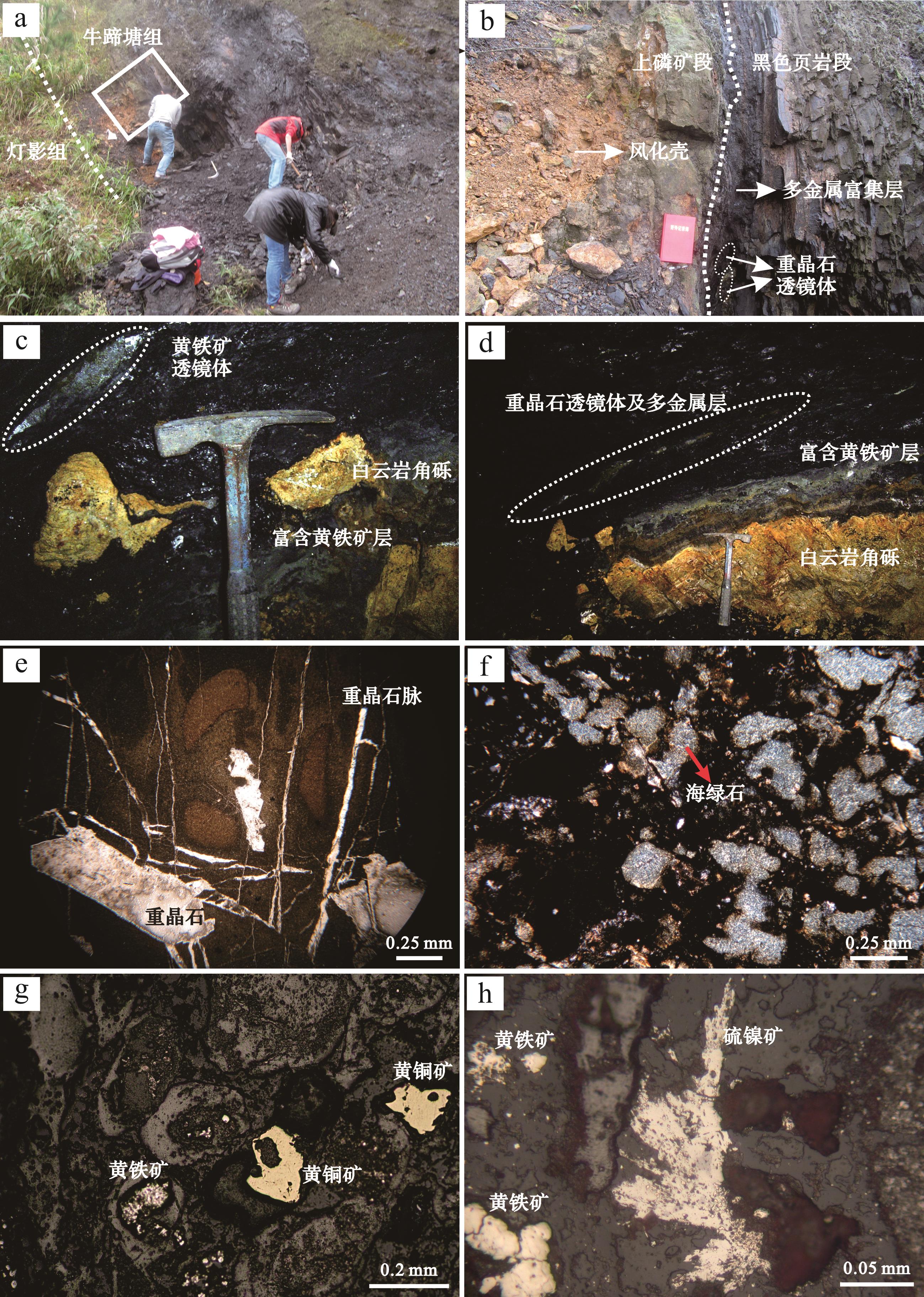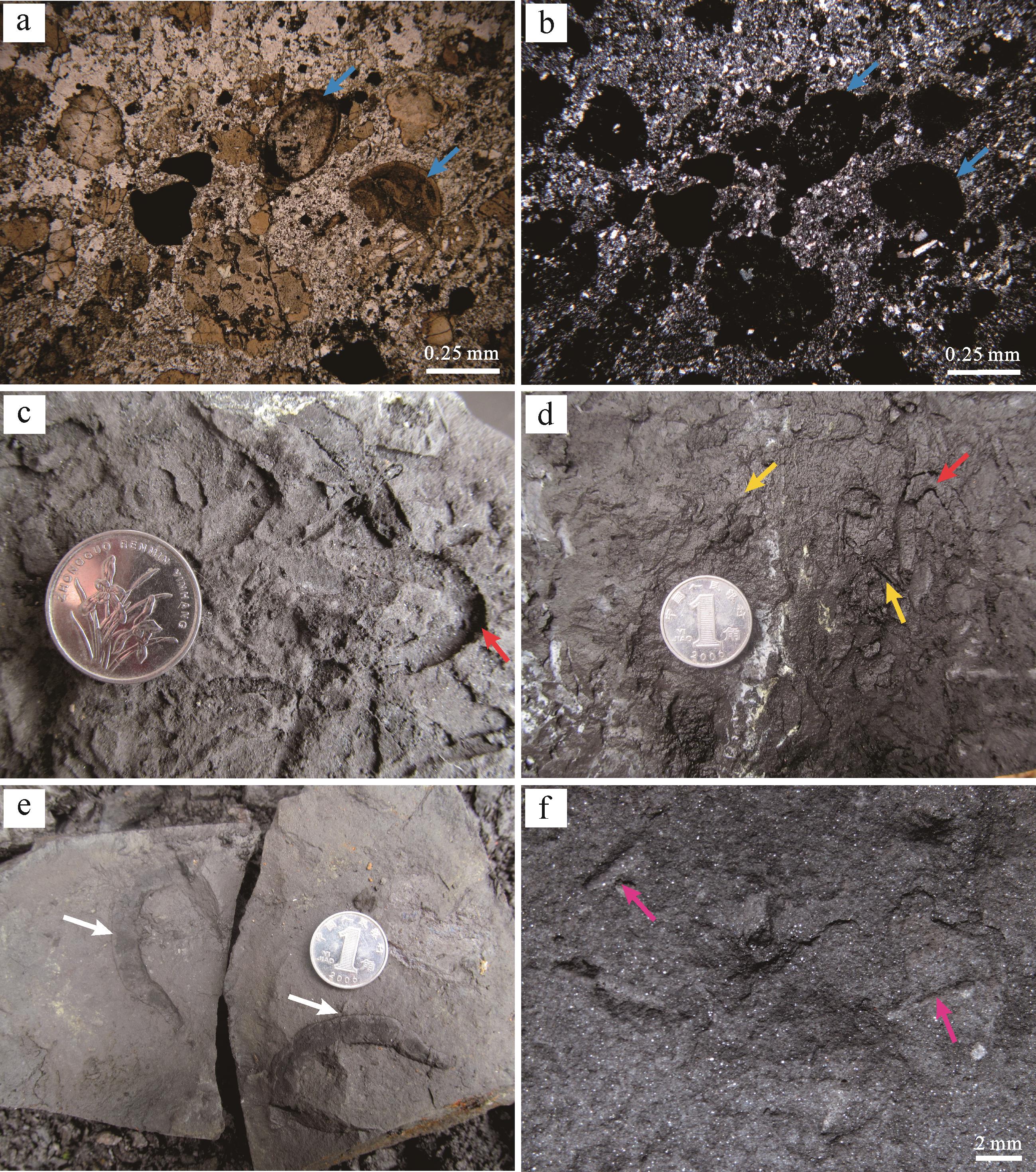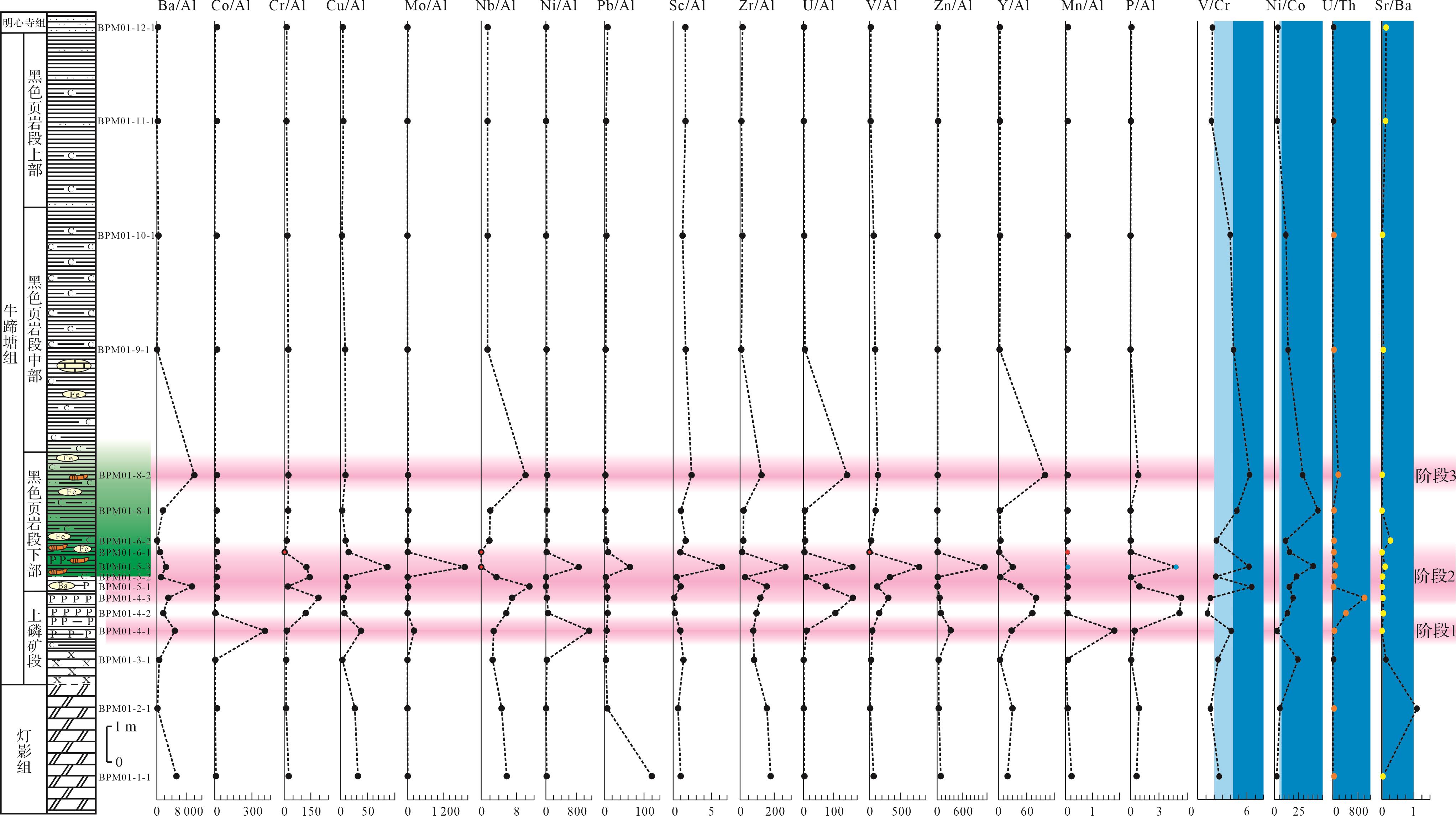HTML
-
华南地区下寒武统牛蹄塘组为一套黑色页岩组成的岩系,底部普遍出现多金属富集层,同时也含有丰富的古生物化石,包括节肢动物、海绵动物、腔肠动物、软舌螺类、蠕形动物、古杯类、半索动物、双壳类及宏观藻类等。生物群的整体面貌以海绵类和节肢类动物为主,经研究属于布尔吉斯页岩型生物群[1⁃14]。该生物群出现于小壳动物群之后、澄江生物群出现之前,为研究寒武纪大爆发的程度和具体进程提供了重要资料[1,10,15]。同时,作为连接两个重要生物群演化关键时期的生物群代表,其所在层位的古环境特征也必将为研究早期生物演化与环境的协同关系提供重要证据。
庞艳春等[14]在贵州瓮安磷矿区进行考察时发现,寒武系底部牛蹄塘组含有大量以碳质印模/印痕形式保存的化石,以蠕虫状和管状为主,主要集中出现于镍、钼多金属层之上的黑色页岩中,在之上的地层中迅速消失。近年来的研究也多集中在多金属层的富集机制、古海洋氧化还原环境、生物地球化学循环及资源潜力等方面[16]。研究结果显示,多金属层/矿床的形成存在以下观点:缺氧条件或深海上升洋流说[17],热水沉积或喷发沉积说[18⁃21],生物成因[22⁃24],以及上述多种因素共同参与的结果[25⁃28]。造成上述争议的重要原因之一是目前缺乏对整个牛蹄塘组古生物群变化和古环境特征变化的综合研究。因此,本文在前期对瓮安大信北斗山磷矿区的牛蹄塘组沉积特征及沉积相分析的基础上[14,29],对整个牛蹄塘组的地球化学特征变化开展综合研究,这一研究不仅有助于正确理解牛蹄塘组生物群的发生、发展与环境变化的关系,同时也可以为区内镍、钼多金属层的形成环境提供约束。
-
瓮安大信北斗山磷矿区构造上位于川黔S—N走向构造带的白岩—高坪背斜中,该背斜控制着本区牛蹄塘组及多金属矿层的展布(图1)。在矿区高坪矿段至白岩矿段内,牛蹄塘组与下伏地层灯影组界线出露较好,牛蹄塘组特征横向分布稳定,典型剖面包括水银山、麻冲、新桥、根皮沟、山屯、大塘、英坪等露头剖面或矿洞剖面[29⁃30]。其中,桅杆坪村的山屯剖面(也称桅杆坪剖面)为露头剖面,牛蹄塘组出露最为完整,灯影组与牛蹄塘组界线清楚(图2a)。

Figure 1. Stratigraphic column and location of the Shantun section in the Weng'an phosphate mining area, Guizhou province (modified from references [14,29])

Figure 2. Outcrop characteristics and bottom boundary features of the Niutitang Formation in the Weng'an phosphate mining area, Guizhou province
区域上灯影组以灰白色的厚层至块状白云岩为主,反映了潮坪环境为主的特征;而上覆明新寺组以灰黄、灰绿色粉砂质黏土岩夹中厚层钙质砂岩、粉砂岩为主,反映了正常浅海环境。牛蹄塘组以黑色薄层页岩为主,特征明显,可分为两段(图2b):上磷矿段和黑色页岩段,总体上反映了以深水滞留的古海洋环境为主。
-
上磷矿段,岩性以黄褐色—灰黑色中薄层磷质页岩为主,富含磷质结核体,直径以2 cm左右为主,可见白云岩角砾(图2c,d),顶部可见海绿石砂岩。上磷矿段底部,可见黄褐色的风化壳,该段与下伏灯影组灰白色的白云岩呈平行不整合接触关系;上磷矿段上部,为灰绿色、黑色海绿石砂岩和含海绿石的黑灰色磷块岩。上磷矿段沉积时,总体环境为滨岸至较深的浅海陆棚环境。
上磷矿段底部常见形态不规则的白云岩角砾/砾屑和黄铁矿碎屑。例如瓮安矿区内麻冲矿洞的上磷矿段与多金属矿层界线特征最为典型:上磷矿段中脉状、碎屑状黄铁矿和白云岩角砾发育,特别是砾径较大的白云岩角砾具有磨圆度差、形状不规则的特征(图2c,d)。镜下特征显示,磷块岩也发育砂砾屑结构,粒屑成分主要为磷质砾屑和磷质砂屑,还可见少量的黄铁矿碎屑、磷质的生物碎屑、重晶石细脉或晶型较好的重晶石矿物(图2e)。在含海绿石磷块岩或海绿石砂岩中,常见黄铁矿矿物[29⁃30]。海绿石矿物具有原地海绿石矿物的特征,并以不规则状为主(图2f)。海绿石与黄铁矿共生表明沉积时的水体环境较深且具有弱还原特征,而不规则状海绿石的存在则表明其在沉积过程中受到了其他颗粒的碰撞和挤压[31]。综上所述,上磷矿段沉积时的古海洋环境局部具有较强的水动力。
-
黑色页岩段,以黑色薄层炭质页岩为主,具水平层理和泥质结构,可见完整的管状化石和少量海绵化石碎片。该段与上覆明心寺组灰绿色至灰黑色薄层粉砂岩、页岩整合接触,岩性特征呈渐变关系。黑色页岩段沉积时整体为水动力较弱的深水陆棚边缘盆地环境。
黑色页岩段下部,以黑色中薄层炭质页岩、含炭粉砂质页岩为主,发育纹层状或结核状的黄铁矿,还可见重晶石透镜体或结核体,Ni-Mo-V多金属层位于黑色页岩段的底部(图2b~d)。黑色页岩段中部,为黑色极薄层至薄层炭质页岩,局部偶见褐铁矿化透镜体和灰岩透镜体,反映黑色页岩段中部沉积时的水体仍为较深的还原环境,但灰岩透镜体的出现反映局部时间段存在充氧现象。黑色页岩段上部,以黑色薄层炭质页岩为主,夹灰色钙质粉砂质页岩或泥质粉砂岩,此时沉积环境仍为具有还原特征的古海洋,但浅色钙质砂岩的出现及砂质含量的增加,反映了古海洋的还原性质在逐渐减弱,水体逐渐变浅。多金属层的矿石结构与磷块岩结构相似,以粒屑结构为主,粒屑成分常见磷质团粒、炭质球粒与黄铁矿碎屑,在炭质球粒的核心可见黄铁矿,黄铜矿、硫镍矿、闪锌矿等金属矿物常呈他形粒状或他形集合体分布于矿石中(图2g,h),也可见黄铁矿、黄铜矿、闪锌矿和方铅矿共生[32]。以上多金属矿石中砂砾屑结构的发育表明,多金属矿层形成时期的古海洋环境中局部地区也具有较强的水动力。
-
野外剖面的详细采样、观察及薄片特征显示,研究区牛蹄塘组由下到上的古生物化石富集发生了明显的变化。上磷矿段上部层位中,开始出现了少量的海绵骨针及微体化石碎片,局部地区可见微小的管状化石。化石个体较小,以直径小于0.5 mm居多,壳体成分主要为磷质。该层位化石相当于小壳化石富集层位(图3a,b)。在黑色页岩段下部,特别是多金属层上部或紧覆其上的黑色页岩底部,是牛蹄塘组生物群化石的出现层位也是主要富集层位,与遵义等地区的松林生物群(牛蹄塘组下生物群)的层位一致。化石以宏观碳质印模/印痕的形式保存,个体较大者长度可达5 cm以上(图3c~e)。化石富集处,密集堆积,不易剥离。经仔细鉴定,牛蹄塘组生物群化石以蠕虫状化石和疑似杆壁虫类化石为主,还常见管状类化石、遗迹化石,以及少量的软舌螺、海绵骨针等化石[14]。而在黑色页岩段中上部层位中,化石数量急剧减少甚至无。局部仍可见管状化石,个体较小,长度一般小于1 cm、直径通常小于1 mm(图3f)。牛蹄塘组生物群在层位上的变化表明,该生物群明显出现在小壳生物群之后并迅速繁盛,在多金属富集层事件结束后又迅速衰退。
1.1. 上磷矿段
1.2. 黑色页岩段
1.3. 牛蹄塘组生物群层位及变化
-
为探讨牛蹄塘组生物群出现和繁荣的重要因素,本文在沉积环境重建的基础上分析了整个牛蹄塘组的常、微量元素及稀土元素特征。样品来自福泉桅杆坪村山屯剖面前寒武系—寒武系界线地层灯影组顶部、牛蹄塘组和上覆地层明心寺组底部的地层,包括白云岩、风化壳、磷块岩和黑色页岩。
-
当SiO25%:样品用无水四硼酸锂熔融,以硝酸铵为氧化剂,加氟化锂和少量溴化锂作助熔剂和脱模剂,在熔样机上于1 150 ℃~1 250 ℃熔融,制成玻璃样片,在Axios X荧光仪上进行测定。当SiO2≤5%:样品用氢氧化钠熔融,热水浸取,盐酸酸化,定容至100 mL,分取部分溶液进行硅钼蓝光度法测定。当P2O51%:样品采用盐酸+硝酸+氢氟酸+高氯酸溶解,ICP-OES全谱仪等离子发射光谱法测定。当P2O5≤1%:样品采用硫酸+氢氟酸溶解,定容至100 mL,分取部分溶液进行磷钼蓝光度法测定。
-
将40 mg岩石样品置于Teflon密封溶样器中,加入l mL浓HF和0.3 mL 1∶1 HNO3,用超声波振荡后置于150 ℃电热板上蒸干样品,再次加入l mL HF、0.3 mL 1∶1 HNO3,加盖密封加热(100 ℃)7~10 d。待溶液蒸干后加入2 mL 11∶1 HNO3,恒温24 h,再次蒸干,加入2 mL 1∶1 HNO3溶解盐类,用l% HNO3将样品溶液转移到50 mL聚乙烯塑料瓶中,加入Rh内标溶液,以1% HNO3稀释至40 g,待ICP-MS测定。
样品的常微量元素(包括稀土元素)测试工作均是在中国地质科学院地球物理地球化学勘查研究所完成的,测试结果及数据分析如表1、2和表3所示。
样品编号 岩石类型 SiO2 Al2O3 Fe2O3 FeO MgO CaO Na2O K2O MnO P2O5 TiO2 LOI TOTAL TFe2O3 BPM01-01-01 白云岩 5.50 0.43 0.19 0.05 19.44 27.21 0.15 0.05 0.067 0.33 0.001 46.52 99.94 0.25 BPM01-02-01 白云岩 7.52 0.68 0.16 0.05 20.42 25.88 0.13 0.02 0.035 0.73 0.001 44.37 99.99 0.21 BPM01-03-01 风化壳 64.86 4.36 1.20 0.08 4.35 8.48 0.04 1.16 0.046 0.20 0.216 14.95 99.93 1.29 BPM01-04-01 黑色页岩 45.83 11.68 3.68 0.05 1.07 2.51 0.12 1.48 14.510 5.92 0.095 12.91 99.85 3.74 BPM01-04-02 磷块岩 12.58 5.73 2.23 0.05 2.69 33.87 0.07 0.26 0.011 35.86 0.033 2.91 96.30 2.29 BPM01-04-03 磷块岩 11.22 5.66 1.13 0.05 2.21 36.23 0.09 0.31 0.010 36.62 0.018 2.73 96.29 1.19 BPM01-05-01 黑色页岩 42.00 10.88 0.75 0.28 1.70 16.03 0.12 2.11 0.001 12.13 0.025 6.58 92.61 1.06 BPM01-05-02 黑色页岩 47.76 25.60 0.99 0.35 1.12 0.13 0.09 3.15 0.001 1.09 0.299 19.41 99.99 1.38 BPM01-05-03 磷块岩 12.96 4.34 66.60 0.48 — 0.20 — 0.45 0.045 25.29 0.105 15.65 126.11 67.13 BPM01-06-01 黑色页岩 33.47 9.38 22.74 1.56 — 0.01 0.14 1.00 — 0.18 0.297 28.02 96.80 24.47 BPM01-06-02 黑色页岩 61.43 15.45 5.12 0.99 0.91 0.18 0.08 2.60 0.010 0.31 0.691 12.21 99.99 6.23 BPM01-08-01 黑色页岩 67.22 15.82 0.17 1.05 0.62 0.08 0.10 2.67 0.005 0.10 0.805 11.18 99.82 1.33 BPM01-08-02 磷质页岩 40.91 9.70 1.60 1.08 1.60 12.61 0.15 1.33 0.001 9.52 0.388 14.33 93.22 2.80 BPM01-09-01 黑色页岩 63.10 15.93 2.40 0.79 1.00 0.13 0.10 3.74 0.011 0.14 0.614 12.06 100.00 3.27 BPM01-10-01 黑色页岩 68.78 16.83 0.70 0.56 0.77 0.27 0.11 3.59 0.008 0.22 0.609 7.56 100.00 1.32 BPM01-11-01 黑色页岩 60.85 18.65 2.63 2.76 1.88 0.92 0.13 3.78 0.077 0.09 0.645 7.56 99.96 5.69 BPM01-12-01 黑色页岩 58.54 17.87 2.70 3.84 2.71 1.65 0.13 3.64 0.107 0.14 0.640 8.00 99.97 6.96 注: “—”代表未测出含量;编号为BPM01⁃05⁃03的样品,铁含量较高,测试数据仅供参考。Table 1. Major element test results of the Shantun section in the Weng'an phosphate mining area, Guizhou province (%)
样品编号 Ba Co Cr Cs Cu Ga Ge Hf Mo Nb Ni Pb Rb Sc Sr Ta Th U V Zn Zr Y Sr/Ba U/ Th V/Cr Ni/Co BPM01-01-01 1 139.20 2.11 5.40 0.56 7.27 0.14 0.20 0.16 2.16 1.32 4.80 27.15 1.20 0.22 40.40 0.01 0.08 0.46 14.10 18.76 7.10 4.36 0.04 5.75 2.61 2.27 BPM01-02-01 52.00 0.35 3.00 0.53 9.48 0.06 0.21 0.14 0.76 1.65 2.00 2.56 1.50 0.23 56.60 0.01 0.10 0.31 4.40 10.49 7.20 10.76 1.09 3.10 1.47 5.71 BPM01-03-01 1 401.00 2.14 20.80 3.36 7.27 5.74 0.89 1.89 1.63 6.05 52.00 9.36 30.20 3.03 189.10 0.19 3.00 1.46 51.70 74.18 64.50 7.99 0.13 0.49 2.49 24.30 BPM01-04-01 29 623.30 2 504.42 65.20 12.42 231.91 7.96 0.92 2.64 1 324.36 17.49 6 982.50 35.25 52.40 5.70 475.00 0.42 6.78 63.30 269.40 1975.05 73.80 171.50 0.02 9.34 4.13 2.79 BPM01-04-02 4 886.80 12.42 371.00 1.36 21.85 2.58 0.32 1.94 23.60 17.16 163.80 24.71 18.20 0.60 290.00 0.08 0.78 323.47 462.20 260.83 23.50 219.25 0.06 414.71 1.25 13.19 BPM01-04-03 9 147.30 3.89 579.30 1.50 17.00 3.31 0.16 3.61 34.03 20.90 73.80 22.84 27.40 0.47 356.70 0.05 0.49 492.67 894.40 160.23 29.50 241.25 0.04 1 005.45 1.54 18.97 BPM01-05-01 53 730.40 0.75 107.70 21.01 75.86 29.49 0.27 3.85 164.47 62.81 11.50 32.82 67.80 5.53 905.80 1.56 17.20 434.47 708.00 25.92 208.40 266.00 0.02 25.26 6.57 15.33 BPM01-05-02 15 661.00 2.71 1 953.50 7.99 139.07 19.98 0.71 7.87 93.13 46.86 61.60 50.42 88.80 6.00 395.90 2.36 8.56 119.57 4 379.10 34.99 195.00 60.36 0.03 13.97 2.24 22.73 BPM01-05-03 5 450.00 49.10 290.00 4.49 197.10 25.26 0.13 0.60 4 350.00 — 1 970.00 148.18 13.00 14.58 610.00 0.17 4.71 376.37 1 820.00 2 602.29 30.00 70.20 0.11 79.91 6.28 40.12 BPM01-06-01 4 150.00 6.25 — 3.41 74.23 7.25 0.13 3.58 63.39 — 100.00 47.80 33.40 4.49 60.00 0.36 2.38 13.85 — 16.59 116.20 7.01 0.01 5.82 — 16.00 BPM01-06-02 576.80 15.50 98.60 9.16 72.58 19.16 0.59 5.97 115.25 15.29 179.20 35.81 82.60 13.06 153.60 0.78 10.81 42.80 222.00 48.74 194.20 35.19 0.27 3.96 2.25 11.56 BPM01-08-01 13 616.40 3.43 166.30 9.26 23.58 19.18 1.31 7.39 277.47 17.05 155.00 21.96 79.50 8.62 170.60 0.89 7.65 35.75 792.60 16.59 253.60 21.71 0.01 4.67 4.77 45.19 BPM01-08-02 50 878.70 4.82 108.40 5.61 45.88 10.63 0.44 5.08 93.57 51.37 140.40 13.63 85.90 12.19 643.80 0.61 4.36 751.07 687.90 39.47 258.80 505.63 0.01 172.26 6.35 29.13 BPM01-09-01 1 098.90 9.19 174.80 15.69 70.20 20.96 0.71 4.42 56.91 11.99 128.00 28.00 129.00 13.68 58.20 2.01 9.25 32.69 761.80 65.56 154.50 20.89 0.05 3.53 4.36 13.93 BPM01-10-01 3 744.20 2.06 150.60 14.62 25.09 23.57 1.21 4.22 27.55 13.09 24.50 45.47 137.30 10.88 117.80 1.03 8.32 18.48 599.90 54.68 149.50 24.05 0.03 2.22 3.98 11.89 BPM01-11-01 671.90 18.66 106.50 12.68 50.02 24.05 1.63 4.29 8.19 13.97 54.80 46.86 145.60 15.78 81.60 0.96 9.30 5.50 180.70 211.00 145.70 26.83 0.12 0.59 1.70 2.94 BPM01-12-01 662.40 18.06 106.50 11.73 42.68 21.74 1.63 4.28 4.41 14.30 60.90 76.49 141.90 14.87 89.40 0.91 9.97 4.64 186.20 180.43 147.20 23.19 0.13 0.47 1.75 3.37 地壳丰度[33] 463.00 24.70 127.00 1.23 56.00 16.70 1.60 4.50 1.43 18.30 81.30 14.00 108.00 16.00 382.00 1.60 7.60 2.07 143.00 76.30 148.00 27.70 注: 表中样品编号的岩性与表1中相同编号的样品岩性一致;“—”代表未测出含量。Table 2. Trace element test results of the Shantun section in the Weng'an phosphate mining area, Guizhou province (10-6)
样品编号 La Ce Pr Nd Sm Eu Gd Tb Dy Ho Er Tm Yb Lu ∑REE LREE/HREE δEu δCe BPM01-01-01 2.62 1.66 0.51 2.13 0.39 0.10 0.44 0.07 0.41 0.09 0.26 0.04 0.20 0.03 8.95 4.81 1.07 0.29 BPM01-02-01 7.18 2.77 1.20 5.78 1.04 0.22 1.11 0.16 0.98 0.20 0.60 0.09 0.52 0.07 21.92 4.88 0.98 0.22 BPM01-03-01 11.34 17.58 2.29 8.46 1.58 0.30 1.34 0.24 1.31 0.27 0.80 0.14 0.86 0.13 46.64 8.16 0.94 0.80 BPM01-04-01 10.76 48.93 4.32 24.66 7.33 1.77 12.21 2.49 15.62 3.77 11.78 1.83 10.26 1.51 157.24 1.64 0.88 1.71 BPM01-04-02 69.21 64.08 13.44 61.82 12.93 2.91 19.45 3.53 20.34 4.38 12.23 1.72 9.15 1.23 296.42 3.12 0.86 0.50 BPM01-04-03 82.78 64.88 15.12 68.8 13.98 3.04 20.05 3.60 20.48 4.46 12.64 1.75 9.11 1.17 321.86 3.39 0.85 0.44 BPM01-05-01 29.43 80.78 14.73 83.09 32.92 2.40 42.71 8.74 46.33 8.54 22.30 3.38 19.75 2.64 397.74 1.58 0.30 0.92 BPM01-05-02 14.47 24.54 4.30 20.41 6.93 1.31 9.06 2.04 11.86 2.35 7.14 1.26 7.94 1.06 114.67 1.68 0.78 0.74 BPM01-05-03 60.43 78.03 13.02 55.79 11.28 2.15 10.29 1.85 9.77 1.91 5.50 0.90 5.37 0.68 256.97 6.08 0.94 0.66 BPM01-06-01 3.69 9.65 1.75 7.65 1.37 0.20 0.84 0.17 1.04 0.24 0.81 0.16 1.09 0.15 28.81 5.40 0.89 0.92 BPM01-06-02 57.13 92.13 11.88 47.36 8.12 1.53 6.59 1.12 5.94 1.16 3.44 0.59 3.93 0.57 241.49 9.35 0.98 0.84 BPM01-08-01 15.12 29.36 4.30 17.58 3.32 0.71 3.21 0.69 4.30 0.97 3.14 0.54 3.61 0.52 87.37 4.15 1.02 0.86 BPM01-08-02 23.12 88.34 21.14 142.97 50.17 15.47 67.78 12.45 65.54 12.63 32.45 4.05 19.95 2.48 558.54 1.57 1.25 0.95 BPM01-09-01 27.52 53.14 6.75 24.89 4.23 0.73 2.94 0.58 3.55 0.75 2.55 0.46 3.21 0.47 131.77 8.08 0.97 0.93 BPM01-10-01 16.55 39.85 5.92 25.59 5.02 1.01 4.23 0.72 4.04 0.84 2.64 0.47 3.10 0.45 110.43 5.70 1.04 0.95 BPM01-11-01 45.10 75.88 9.44 35.01 6.34 1.24 5.21 0.90 4.93 1.00 3.11 0.52 3.51 0.52 192.71 8.78 1.02 0.87 BPM01-12-01 35.11 58.99 7.55 28.03 5.00 0.98 4.23 0.79 4.28 0.85 2.54 0.43 2.79 0.41 151.98 8.31 1.00 0.86 注: 表中样品编号的岩性与表1中相同编号的样品岩性一致;δEu和δCe值是经过北美页岩标准化后计算的值;计算公式:δEu=EuN /(SmN×GdN)1/2,其中,EuN、SmN、GdN为标准化值;δCe = CeN/(LaN×GdN)1/2,其中,CeN、LaN、PrN为标准化值。Table 3. Rare earth element test results of the Shantun section in the Weng'an phosphate mining area, Guizhou province (10-6)
2.1. 常量元素
2.2. 微量元素
-
1) V/Cr比值
微量元素V/Cr比值范围,可以判断环境中的含氧程度[34],具体如表4所示。当V/Cr比值小于2.0时,属于氧化的古海洋或正常的古海洋;当V/Cr比值介于2.0~4.25时,为贫氧的古海洋;当V/Cr比值大于4.25时,属于缺氧的古海洋。
微量元素 氧化的古海洋(正常海洋环境) 贫氧的古海洋 缺氧的古海洋 V/Cr 2.0 2.00~4.25 4.25 Ni/Co 5.0 5.0~7.0 7.0 Table 4. Range of V/Cr and Ni/Co ratios in different ancient marine environments[34]
山屯剖面样品的V/Cr比值介于1.25~6.57(表2、图4)。牛蹄塘组上磷矿段下部白云岩的V/Cr比值较低,1个样品的V/Cr比值(V/Cr=1.47)属于正常海洋环境的比值范围;1个样品的V/Cr比值(V/Cr=2.61)属于贫氧海洋环境的比值范围,但接近正常海洋环境的比值。黄褐色的风化壳样品的Ni/Co比值为2.49,不能用来判断古海洋环境。在上磷块岩段上部至黑色页岩段的12个样品中,3个V/Cr比值小于2,属于正常海洋环境的比值范围;4个样品的比值介于2~4.25,落在贫氧海洋环境的比值范围;5个样品的V/Cr比值大于4.25,属于缺氧海洋环境的比值范围。明心寺组1个样品,V/Cr比值为1.75,也属于正常海洋环境的比值范围。

Figure 4. Changes in element content and ratio characteristics of the Mast flat section in the Weng'an phosphate mining area, Guizhou province
2) Ni/Co比值
根据微量元素Ni/Co比值范围,同样可以判断环境含氧程度[34],具体如表4所示。当Ni/Co比值小于5时,属于氧化的古海洋或正常的古海洋;当Ni/Co比值介于5.0~7.0时,属于贫氧的古海洋;当Ni/Co比值大于7.0时,属于缺氧的古海洋。
山屯剖面Ni/Co比值范围比较大(0.40~328.45)(表2、图4)。上磷矿段下部白云岩的Ni/Co比值较低,1个样品(V/Cr=2.27)属于正常海洋环境的比值范围,1个样品(V/Cr=5.71)指示贫氧海洋环境,但比值非常接近正常海洋环境的比值范围。黄褐色的风化壳样品的Ni/Co比值为24.30,不能判断古海洋环境。在上磷块岩段上部至黑色页岩段中,13个样品中,2个Ni/Co比值小于5,属于正常海洋环境的比值范围;11个样品的Ni/Co比值大于7.0,指示缺氧海洋环境;其中多金属层样品的Ni/Co比值最大。明心寺组1个样品,Ni/Co比值为3.37,也属于正常海洋环境的比值范围。
以上微量元素V/Cr、Ni/Co比值范围综合表明:牛蹄塘组上磷块岩段下部的沉积环境为正常海洋至贫氧海洋环境,与沉积特征反映的滨海潮坪环境一致;而上磷矿段上部至黑色页岩段的沉积环境以缺氧还原环境为主,这与沉积特征反映的主体为缺氧深水环境,局部时间段存在短暂充氧的古海洋环境一致;明心寺组为正常的海洋环境,与沉积特征反映的浅海陆棚环境一致。由此可知,除了风化壳样品,其余样品的微量元素V/Cr比值基本保留了其原始沉积时期古海洋的氧化还原特征。
-
U/Th比值同样可以用来判断沉积环境中的氧化还原性质[35]:在缺氧条件下,U被还原为不溶性的铀(U4+)氟化物络合物,可以保存在沉积物中,在氧化环境中,它被转化为可溶性的碳酸铀酰(U6+),在溶液中被去除,因此提出缺氧沉积物的Th/U比值较低,一般低于2,而含氧海洋沉积物的比率较高,分布在2~7,强氧化陆地环境的比值则超过7(表2)。Jones et al.[34]曾基于对挪威和英国侏罗系的一套泥质岩的研究结果提出,当U/Th比值小于0.75,为氧化环境;当U/Th比值为0.75~1.25时,为低氧环境;当U/Th比值大于1.25时,为缺氧环境(表5)。
Table 5. Range of U/Th ratios in different ancient marine environments
瓮安牛蹄塘组样品的U/Th比值变化明显(表2、图4)。如果按照表2中的数据统计值,磷块岩段上部及黑色页岩段样品的U/Th比值多数大于2(U/Th=2.22~1 005.45),只有牛蹄塘组顶部一块样品小于2(U/Th=0.59),表明磷块岩段上部及黑色页岩段沉积环境主体属于缺氧范围,向上出现含氧量增高的现象,这与沉积特征反映的滞留深水环境、局部范围短暂充氧的结果是一致的。上覆明心寺组底部页岩样品的U/Th比值(U/Th=0.47)明显小于0.75,属于氧化范围,这与沉积特征反映的浅海环境也是一致的。而灯影组白云岩的U/Th比值(U/Th=3.10~5.75)大于3,也属于缺氧环境的范围,与白云岩反映的局限海盆环境一致。而风化壳的比值为0.49,由于Th在低温地表环境中相对稳定,在风化过程中集中在抗性矿物中,所以比值较低,因此不能判断古海洋环境。因此,本区牛蹄塘组的U/Th比值,除了风化壳样品,其余样品均保留了其原始沉积时期古海洋的氧化还原特征。
Rona[36]曾提出,一般情况下,热水沉积岩中的U/Th比值大于1,水成沉积岩中的U/Th比值小于1。那么U/Th比值大于1的样品,是热水成因导致,还是还原环境导致?研究区所测样品中(表2),磷块岩段上部及黑色页岩段底部的U/Th比值极高,最高可达1 005.45,远大于1。这暗示磷块岩段上部及黑色页岩段底部沉积时期,还原的古海洋环境中可能存在热液活动,岩石样品具有极高的U/Th比值是还原环境叠加热液活动双重作用的结果。
-
Sr、Ba是化学性质相似的碱金属元素,不仅可以用Sr/Ba值的变化来判断海、陆相沉积物,而且可以作为衡量海底热水流体作用的指标[36]。例如广东大宝山矿床(泥盆纪地层)中的热液沉积岩的Sr/Ba比值小于1(最低Sr/Ba=0.04),非热液沉积岩的Sr/Ba比值大于1(大理石的Sr/Ba=7,正常灰岩的Sr/Ba=20)[37];现代冲绳海槽的沉积物也具有这个特点,海底火山喷发产物灰白色浮岩的Sr/Ba比值小于1(Sr/Ba=0.200~0.444)[38],非热水沉积物的Sr/Ba比值大于1(Sr/Ba=1.243)[39]。但也有资料显示[40],深海与滞留浅海环境的Sr/Ba比值也小于1。因此,Sr/Ba比值小于1,既可能是热水沉积作用导致的结果,也可能是还原的古海洋环境导致的结果。
本文所测岩石样品的Sr/Ba比值如表2所示:灯影组顶部白云岩有1块样品大于1(Sr/Ba=1.09),另1块样品的Sr/Ba比值小于1(Sr/Ba=0.04);牛蹄塘组样品的Sr/Ba比值均小于1(Sr/Ba=0.01~0.27);明心寺组底部样品的Sr/Ba比值为0.13。根据牛蹄塘组的沉积特征可知,这些样品Sr/Ba比值均小于1,缺氧的古海洋环境有重要贡献。但从图4可以看出,牛蹄塘组上磷矿段上部和黑色页岩段下部的部分样品,其Sr/Ba比值达最低(Sr/Ba=0.01~0.03)。由此推测,上磷矿段上部和黑色页岩段下部Sr/Ba比值达极低的原因,可能是在缺氧的古海洋沉积环境中还存在热液活动的叠加而导致的。
-
考虑到元素含量容易受沉积速率的影响,而元素含量/Al的比值能够排除沉积速率的影响[41],因此文中讨论牛蹄塘组元素含量变化时,采用了元素含量/Al的比值,如图4所示。
研究区牛蹄塘组微量元素只在上磷矿段上部和黑色页岩段下部呈现突然富集的特征。根据微量元素在剖面上的变化特征,将其富集事件细分为三个阶段:第一阶段,相当于上磷块岩段上部层位,富集的微量元素包括Ni、Mo、Ba、Co、Cs、Y、Cu和Zn等元素;第二阶段,相当于黑色页岩段底部层位,富集的微量元素类别最多,含量也最大,包括Ni、Mo、V、Ba、Cu、Zn、Pb和Cs等元素;第三阶段,相当于紧覆黑色页岩段底部之上的层位,微量元素急剧减少,仅出现了Ba、U和Y元素的富集。另外,常量元素的测试结果显示:牛蹄塘组上磷矿段P2O5含量(峰值含量可达36.62%)及黑色页岩段下部样品中的P2O5含量明显远高于其他层位,相应的也出现了三个富集阶段,与微量元素的富集阶段一致;Fe含量在第二阶段最高,出现了纹层状或透镜状的黄铁矿(表1);Mn含量只在第一阶段中出现了富集现象。以上牛蹄塘组元素含量的变化特征显示,上磷矿段上部和黑色页岩段下部沉积时的古海洋环境中曾发生剧烈变化或特殊地质事件是阶段性发生的,不同阶段带来的元素组合存在一定的差异,并且该事件很快消失。
众多的研究结果统计表明[42],热水沉积成因的沉积岩或沉积物多以富集一些金属元素为特征,黄铁矿是现代黑烟囱中的常见硫化物。但由于不同动力学环境、不同的岩石基底、不同的火山性质和不同的板块构造背景,不同热液沉积物或沉积岩的富集元素类别组合存在明显差异[43]。例如,我国华南地区震旦系黑色热水沉积岩富集Ba、Sb和Hg等元素[44];湘黔寒武系黑色热水沉积岩富集Ba和Sb,另外,Mo、Ni、Co、Cu、Zn、Ce、Bi、Ti、Pb、Li、Cs、W、U等元素也较富集[45⁃46];泥盆系黑色热水沉积岩富集Sb和Ag等元素[47⁃48];二叠系热水沉积岩富集Bi、Au、Ag、Cr和Sb等元素[49]。现代冲绳海槽的热水区沉积物相对于非热水区的沉积物明显富集Mn、Zn、Pb、Au、Ag、Hg等金属元素[39,50];超慢速—慢速扩张洋脊组成的印度洋中脊的热液硫化物总体相对富集Fe、Co和Ni;艾德蒙热液区和EPR21°热液硫化物组成相对富集Pb、Zn、Ag和Sr[51]。
由于瓮安磷矿区与湘黔地区的寒武系具有共同的地质构造背景,因此牛蹄塘组底部富集的金属元素组合整体上与湘黔寒武系黑色热水沉积岩中富集的金属元素类别基本一致。据此判断,研究区牛蹄塘组上磷矿段上部和黑色页岩段下部出现的多金属富集层所代表的阶段性发生的特殊地质事件可能是古海洋环境中的热液活动事件。而多金属层中顺层产出的重晶石透镜体和黄铁矿纹层及透镜体也进一步暗示,牛蹄塘组底部多金属元素的富集可能是阶段性的热液活动事件引发的。
-
瓮安磷矿区牛蹄塘组及上覆和下伏地层中,岩石样品的稀土含量变化范围较大(∑REE=8.95×10-6~558.54×10-6),其中含量最高的样品出现于上磷矿段上部和黑色页岩段层位中(表3),轻稀土LREE为弱富集至富集(LREE/HREE=1.57~9.35)。样品经北美页岩标准化后的配分曲线近于平直(图5),Eu异常值(δEu=0.28~1.16)和Ce异常值(δCe=0.21~1.56)的变化范围也较大。

Figure 5. Distribution pattern of rare earth elements in rock samples from the Niutitang Formation in the Shantun section, Weng'an phosphate mining area, Guizhou province
热化学数据和理论水溶液化学研究显示[52]:氧化条件下,Eu以Eu3+形式存在,不发生分馏,异常不显著;在还原条件下,Eu以Eu2+形式存在,与其他稀土元素发生分馏,Eu呈现负异常;在温度高于约250 °C时,即使存在大量络合作用,三价Eu仍不稳定,二价Eu成为主要存在形式,具有正异常。海底不同热水系统的高温流体除稀土含量变化较大之外,互相之间具有非常类似的REE配分模式,即LREE富集、高的正Eu异常[53⁃55]。而热液活动场所附近的沉积物一般也具有与高温流体相似的配分模式,特别是Eu呈正异常[56⁃58]。另外,典型的热液沉积物稀土元素总量低,具有明显的Ce负异常,而正常沉积岩的稀土特征倾向于富REE和具明显的Ce正异常[47⁃48,58⁃62]。但不同地区又存在不同的配分模式,如太平洋SER(South Explorer Ridge)地区的现代海底热水沉积物的稀土配分模式[63]有三种类型:(Ⅰ)LREE强烈富集和Eu正异常;(Ⅱ)相对较平的分布,Eu正异常,轻微Ce负异常;(Ⅲ)轻微LREE富集和中等Ce负异常。这些模式特征与海水典型的LREE亏损模式明显不同[64]。上述稀土组成的变化反映了热液组分的逐渐减少和海水比例的逐渐增加[57,65⁃66]。特别是当海相热水沉积物不含火山喷发杂质时,作为海相化学沉积物类别之一,就具有了与海水相似的稀土模式:Ce常具有明显负异常,模式曲线近于水平或向左倾[67⁃68]。因此,与古热水作用有关的热水沉积岩,其稀土特征及标准化配分模式与沉积岩样品中的热液成分多少有关。
研究区的样品经北美页岩标准化后,在上磷块岩段和黑色页岩段下部有样品(表3、图5a)具弱至中等的Eu负异常值(δEu=0.30~0.86),Ce具弱至中等异常(δCe=0.44~0.92),稀土含量变化范围大(ΣREE=114.67~397.74),对应轻稀土轻微富集(LREE/HREE=1.58~3.39),配分曲线近于平,与Ⅲ类相似;黑色页岩段中部出现了Eu正异常值(δEu=1.25),对应轻稀土轻微富集(LREE/HREE=1.57),配分曲线近于平(表3、图5b),与上述Ⅱ类相似;其他样品无明显Eu异常,也无明显的Ce异常,特征更接近正常沉积岩特征。灯影组的样品具有明显的Ce异常,轻稀土含量高,接近Ⅲ类,但又不同于Ⅲ类稀土元素特征(表3、图5a)。上覆明心寺组典型的模式曲线是明显的左倾(表3、图5b),属于正常沉积岩特征,与沉积特征一致。由此可知,研究区上磷矿段和黑色页岩段中下部层位沉积时,古海洋环境具有一定热液成分的贡献。
另外,由于Ce从海水中的大量迁移主要发生在开阔的大洋中,而在靠近大陆的海湾口或大陆架,Ce迁移的能力相对较弱,其稀土特征逐渐趋近于海水,故Ce亏损的强度在不同的沉积大地构造环境中各不相同[59,69⁃71]。对美国西海岸加利福尼亚州中生代硅质岩研究结果显示[64],沉积在海洋扩张脊附近的燧石沉积物具有最低的δCe值(平均为0.30),而沉积在洋盆底部的燧石沉积物则具有中等的δCe值(平均为0.58),沉积在大陆边缘的燧石沉积物的δCe值最高(平均为1.03)。研究区样品Ce异常值(δCe=0.44~1.71)变化较大,但只有1块样品的Ce异常值是大于1的(δCe=1.71)。根据Murray et al.[64]的研究结果判断,瓮安磷矿区牛蹄塘组沉积时的古海洋环境以大陆边缘盆地环境为主,但牛蹄塘组下磷矿段及黑色页岩段下部地层沉积时的主体海洋环境介于大洋中脊与洋盆之间,这与沉积特征反映的沉积环境是一致的。
3.2. U/Th比值
3.3. Sr/Ba比值
3.4. 元素含量的变化
3.5. 稀土元素配分曲线特征
-
贵州瓮安磷矿区寒武系底部牛蹄塘组可划分为下部的上磷矿段和上覆的黑色页岩段,黑色页岩段中上部出现灰岩透镜体或钙质砂岩透镜体。多金属层恰好位于这两个岩性段的过渡部位,即上磷矿段上部和黑色页岩段底部。而牛蹄塘组生物群则保存于镍、钼多金属层上部或紧覆其上的黑色页岩下部,化石面貌及数量由下到上具有明显的变化。在多金属层上部或紧覆其上的黑色页岩底部,是牛蹄塘组生物群出现和主要富集层位,化石以宏观碳质印模/印痕的形式保存,化石组合面貌以蠕虫状化石和疑似杆壁虫类化石为主,还常见管状类化石、遗迹化石,以及少量的软舌螺、海绵骨针等化石。而在该层位之上的黑色页岩中,化石数量急剧减少甚至无[14]。研究区岩石样品的微量元素V/Cr、Ni/Co、U/Th和Sr/Ba的比值范围与沉积特征反映的环境是一致的,即整个牛蹄塘组沉积时期的古海洋环境以缺氧还原特征为主,并在黑色页岩段的中上部沉积时期的某个阶段出现短暂的充氧条件。黑色页岩段底部多金属层的出现表明,沉积环境还曾发生过剧烈变化或特殊地质事件。而牛蹄塘组生物群在时空分布上与多金属层呈现出高度的一致性。这种时空耦合关系强烈暗示,牛蹄塘组生物群的出现、繁盛与缺氧或局部时间段的充氧事件并无关联,而与多金属富集事件之间存在密切的成因联系。
针对湘黔寒武系底部多金属层的成因研究众多:金银铂族元素的丰度、比值、相关性、分布模式特征显示,多金属层的形成可能主要与海底热水喷流作用有关[45⁃46];镍钼硫化物矿石的铂族元素的浓度、Pt异常(Pt/Pt*)、Pt/Pd、Ir/Pd、Au/Pd比值与捷克共和国、纳米比亚和加拿大海底火山热液成因的富金属黑色页岩也是相似的[19];湖南西部和贵州遵义地区牛蹄塘组多金属层的元素地球化学、硫同位素以及岩石学等特征,也提供了早寒武纪存在热液喷发的证据[18];磷灰石的微量元素和锶同位素特征[27]、岩石的总有机碳(TOC)、微量元素及铂族元素地球化学的特征[25]则显示,多种来源以及海底热液和生物作用可能是牛蹄塘组多金属Ni-Mo-PGE形成的原因[26,28]。上述对湘黔地区牛蹄塘组多金属层的多尺度、多参数的研究成果相互印证,皆表明多金属层形成过程中存在海底热液活动作用。热液活动向寒武纪古海洋的排放可能对生命产生了重大影响[19]。Steiner et al.[18]就曾提出,牛蹄塘组生物群虽不是严格意义上的喷口生物群,但通过对岩石化学营养初级生产者的初级和次级消费,从而与热液喷口相关。
瓮安磷矿区牛蹄塘组的沉积特征和岩石矿物特征显示,上磷矿段,白云岩角砾发育,磷块岩和海绿石砂岩中常见黄铁矿,黄铁矿呈结核状、脉状、碎屑状,表明当时的环境局部具有较强的水动力。磷块岩和海绿石砂岩中的海绿石矿物以不规则状为主,表明其在沉积过程中曾受到了其他颗粒的碰撞和挤压[31]。在多金属层及附近层位,常见重晶石和黄铁矿呈透镜体顺层产出,特别是黄铁矿尤为富集,常呈纹层状产出(图2b~f)。多金属矿石发育碎屑结构,常见黄铁矿、黄铜矿和辉镍矿等共生(图2g,h)。而现代黑烟囱主要由铜、锌、铁、铅硫化物、重晶石、硬石膏、铁氧化物、非晶质二氧化硅、碳酸盐组成[72]。由此可见,研究区多金属层及附近层位的矿物成分组成与现代大洋底热液黑烟囱的实地观测资料和研究结果基本一致。瓮安磷矿区牛蹄塘组的元素地球化学特征与上述结果也是一致的。牛蹄塘组多数样品U/Th比值大于1、Sr/Ba比值小于1,特别是在多金属层及上下层位中的U/Th比值达最高、Sr/Ba比值达最低,V/Cr和Ni/Co也达最低、微量元素和常量元素的急剧富集,这些地球化学指标的异常可解释为在还原的古海洋环境中有热液成分的叠加所致。另外,在上磷块岩段和黑色页岩段下部有样品具弱至中等的Eu负异常值,Ce具弱至中等异常,稀土含量变化范围大,对应的轻稀土轻微富集,配分曲线近于平;黑色页岩段中部出现了Eu正异常值,对应的轻稀土轻微富集,配分曲线近于平。这些特征介于热液流体与典型海水的稀土元素特征之间,属于热水沉积岩稀土元素特征的变化范畴,与现代海底热水沉积物的稀土配分模式的Ⅱ类和Ⅲ类相似。另外,前期工作也显示,研究区多金属层附近的重晶石具有明显的Eu正异常,具有典型的热水沉积特征[16]。
此次研究还发现,研究区微量元素的富集明显分为三个阶段,相较于第一阶段,第二阶段富集的元素类别和含量明显升高(磷质含量也较高),包括Ni、Mo、V、Ba、Fe、Cu、Zn、Pb和Cs等元素的高度富集。而Fe、Cu、Zn、Pb元素是热液黑烟囱常见的富集元素。而第三个阶段富集的元素类别数量和含量相较于第二阶段急剧减少并最终趋于正常含量(图4)。另外,V/Cr、Ni/Co和U/Th比值的最高值、Sr/Ba比值的最低值就位于第二阶段对应的层位中,表明第二阶段的输入的热液活动成分最多。第二阶段的黄铁矿纹层最为富集,元素含量也显示铁含量最高,元素化学指标异常也集中出现于这一阶段。这些特征暗示热液活动的输入具有阶段性的变化,不同阶段存在一定的差异,其中第二阶段的热液活动最强。这一发现与古生物记录也高度吻合:在热液活动第二阶段对应的层位中,化石数量和类别最丰富。由此可以得出结论,热液活动的发生有利于牛蹄塘组生物群的繁盛。
瓮安磷矿区牛蹄塘组生物群的形态以蠕虫状或其他管状形态为主,可见节肢动物[14]。另外,在湘黔一带牛蹄塘组底部黑色页岩中,微体化石的研究显示,与大量节肢动物、海绵管状化石等同时出现的还有菌藻类化石[20,73],其中鞘硫细菌垫很常见[18]。Xu et al.[24]还在镍、钼硫化物富集层中发现了丰富的微米级的微化石,结构类似于单细胞绿藻。这种特殊的生物组合与现代热水生物群和古热水生物群的构成非常相似:蠕虫状化石及管状化石常见于古喷口生物群中[74⁃76];而蠕虫和节肢动物也是现代喷口生物群中的重要组成类别,其中多毛类蠕虫最为常见,细菌和古细菌(硫细菌等)常呈席状分布于喷口附近,其中最常见的是一种嗜热嗜酸细菌[77⁃79]。因此,牛蹄塘组生物群的构成与典型的热液喷口生物群的生物构成基本一致,揭示了一个完整的生态系统:热液活动提供的化学能量支撑了微生物的繁盛,进而为牛蹄塘组生物群中的后生动物的繁盛提供了必要的食物来源。
综上所述,多金属层及附近层位的沉积特征、矿物成分组成与元素化学特征均暗示,瓮安磷矿区多金属层及其上下层位形成时期,研究区古海洋环境中有热液/热水活动的发生。这也与当时的沉积地质背景是吻合的。前寒武纪以来,该区曾受到一系列区域性深大断裂的影响,沿断裂发生多期次基性、超基性海底岩浆活动[67]。由此推测,当时区域上的深大断裂活动产生的较强动力导致灯影组顶部的白云岩破碎并原地堆积,形成较大的白云岩砾屑,该断裂活动也引发了相关区域的海水沿海底的基底裂隙下渗,被加热的海水在热对流作用下携带以黄铁矿为主的热液流体沿裂隙上涌至海底而形成新的沉积覆盖在含白云岩砾屑的沉积物之上。瓮安磷矿区牛蹄塘组生物群的突然出现和快速繁盛,与热液活动引发的环境改变存在直接的因果关系。根据对牛蹄塘组生物群出现前后的古海洋环境变化的研究结果,重构了瓮安磷矿区牛蹄塘组生物群出现前后的古环境变化模式图(图6)。在牛蹄塘组生物群出现前夕,海底热液上涌活动带来了丰富的多金属元素和能量,逐渐改善缺氧的古海洋环境,开始出现以化能自养为主的微生物或微生物群(图6a)。随着热液活动的累积或加强,特别是第二阶段的热液活动引发的环境改变得到了持续的累积和发展,不仅形成了显著的多金属层,还逐渐形成微生物群或微生物席,构建了一个以化能自养微生物为基础的独特生态系统,这为早期后生动物的辐射演化提供了必要的生态基础,以管状蠕虫生物群出现为特征并迅速繁盛(图6b)。之后,热液活动逐渐减少至消失,古海洋环境又恢复了安静的缺氧状态,虽有短暂的充氧事件的发生,但未能改变牛蹄塘组生物群最终消失的趋势(图6c)。
-
(1) 贵州瓮安磷矿区寒武系底部牛蹄塘组元素地球化学指标(V/Cr、Ni/Co、U/Th和Sr/Ba比值)表明牛蹄塘组沉积时期古海洋整体缺氧,中晚期曾发生过小规模、短期的充氧事件,这与沉积特征一致。上磷矿段底部常见形态不规则的、砾径较大的白云岩砾屑,上覆磷块岩及多金属矿石具有砂/砾屑结构,海绿石矿物形态极不规则,反映当时古海洋局部水体动力较强。
(2) 贵州瓮安磷矿区牛蹄塘组多金属层及紧覆其上的黑色页岩底部发育重晶石透镜体和黄铁矿纹层,矿石中常见黄铁矿、黄铜矿和不规则形态的硫镍矿,与现代洋底热液“黑烟囱”极为相似,代表了热液活动的特征。在上磷矿段上部、多金属层及紧覆其上的黑色页岩底部层位,多项地球化学指标出现异常(V/Cr、Ni/Co、U/Th达峰值,Sr/Ba比值达最低值,P、Fe、Mn及多种微量元素富集),其中Fe、Cu、Zn、Pb元素是热液黑烟囱常见的富集元素;部分样品的稀土元素特征介于热液流体与正常海水之间。综上所述,多金属层代表了一次古海洋环境中的热液上涌事件,地球化学指标异常是热液活动叠加的结果。
(3) 贵州瓮安磷矿区牛蹄塘组生物群的出现及繁盛的层位位于多金属层上部及紧邻之上的黑色页岩中,其时空分布与多金属层分布表现出高度的一致性。微量元素的富集显示热液活动可划分三阶段,其中第二阶段元素的类别和含量最高,化石数量和类别也最为丰富。该生物群以大型蠕虫状和管状化石为主,伴生有大量菌及菌藻类等微体化石,构成与典型的热液喷口生物群高度一致的完整生态系统。上述特征表明,热液活动是导致牛蹄塘组生物群突然出现、迅速繁盛的重要原因。

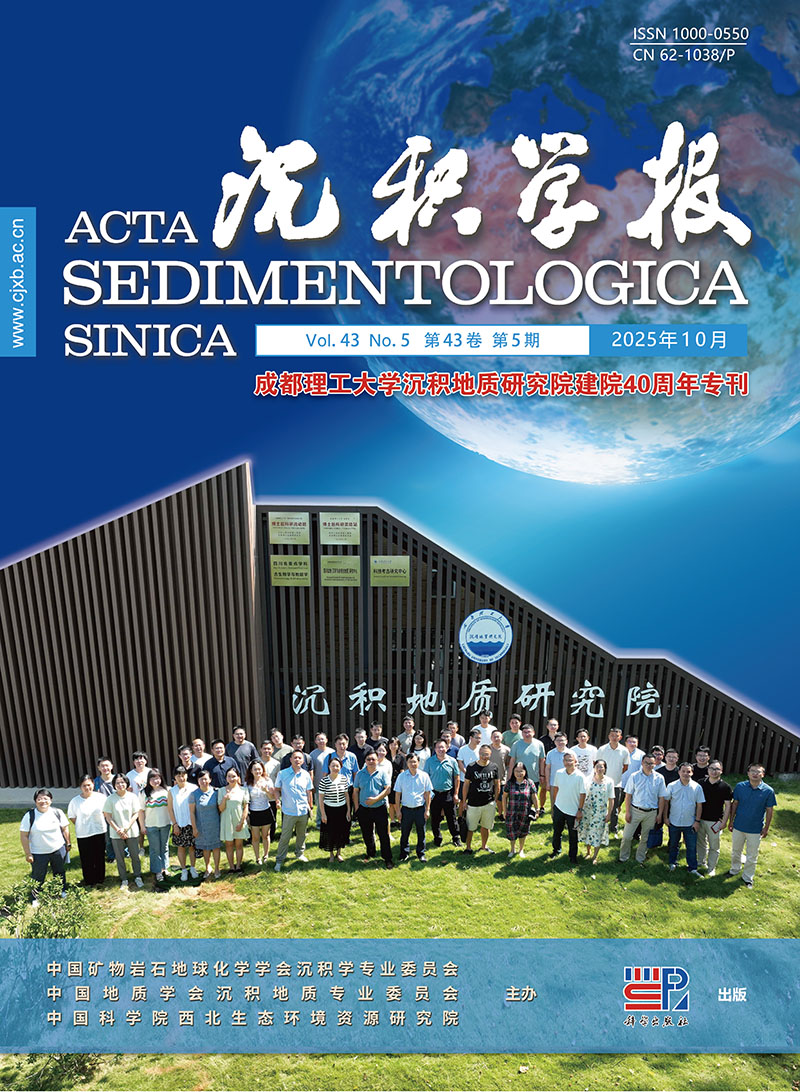


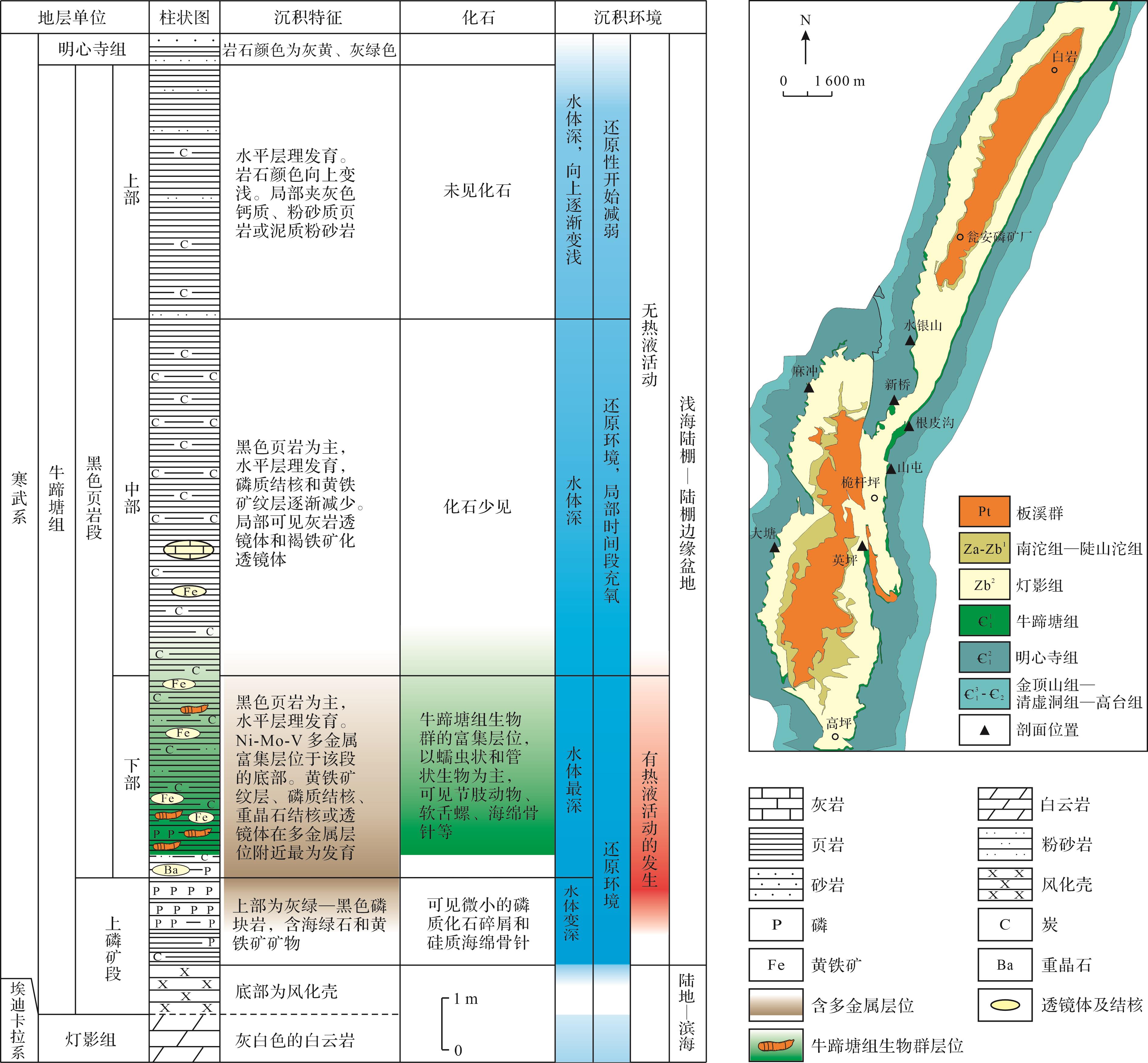




 DownLoad:
DownLoad:
